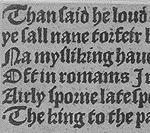Digitisation
The Chepman & Myllar digitisation project
The images of the 'Chepman & Myllar Prints' which appear on this website are the by-product of a major digitisation project aimed at improving access to the National Library of Scotland's unique copies of the nine earliest books printed in Scotland. Outline details of this project are given below. For further information, email Rare Book Collections.
Background
The digitisation, begun in October 1996 and completed in May 1997, had two main aims: first, to improve access to these unique books which are so important to students of Scottish literature and the history of Scottish printing; and second, to protect the originals from unnecessary handling.
All the pieces printed by Chepman and Myllar were digitised, and also the two items not printed at that press but bound with them in the same volume for the last 200 years or more. The work was carried out on the Library's premises, and scanning was carried out on a Kontron digital camera in 24-bit colour and at the highest resolution consistent with covering whole pages in a single scan.
Maximum information
Because the extreme edges of the printed areas of the pages are less visible in their current binding (dating from 1951) than in their previous binding, it was decided also to scan a set of high-quality actual-size black-and-white photographic negatives which had been made in 1946, when the volume was in its previous binding, and used for the annotated facsimile 'The Chepman & Myllar Prints: A facsimile with a bibliographical note by William Beattie' (Edinburgh: Edinburgh Bibliographical Society, 1950). Together, these two series of digital images provide maximum information about the 'Chepman & Myllar Prints'.


Scans from the top left-hand corner of p.34, from the original (on the left) and from the 1946 negative (on the right)
Applications
The low-resolution digital images available on the Library's website help to make the 'Chepman & Myllar Prints' more widely accessible; but the original high-resolution scans, currently available only by special arrangement with the Library (email Rare Book collections), open up new possibilities for in-depth research.
Because the pages scanned are never larger than about 16 x 10 cm, the resolution achieved enables the images to be enlarged by up to 600% before they begin to break up. This facility is of enormous benefit to scholars wishing to carry out detailed examinations, whether, for example, as part of typographical analysis to establish a relative chronology for the undated books or to exploit the manuscript annotations found on a number of pages in several works.
Images showing deterioration
The images below provide just one example of what can be achieved. They show, greatly enlarged, the ladder from Androw Myllar's device as it appears in the various Chepman and Myllar books. They have been arranged roughly in order of the deterioration which affects one of the ladder's rungs, since this may provide a clue to the chronology of the undated items relative to the dated ones, although it is important to remember that the appearance of what is printed depends also on the way in which the printer cleaned and inked the block, etc.
The images come from (left to right): p.148 (undated), p.168 (undated), p.136 (4 April 1508), p.52 (8 April 1508), p.6 (20 April 1508), p.100 (undated), and p.176 (undated).







Different impressions showing the deterioration of the block of Androw Myllar's device.
